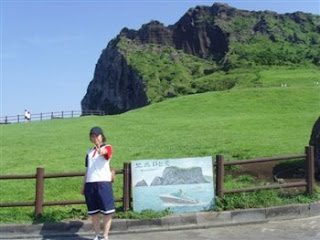Hello? I'm Park Ja-kyeong, and I live in South Korea. I'm 18 years old.
Did you heard of 'Juju island'? I write this letter to introduce to you about beautiful Jeju island. Jeju Island is located in Korea south of the island. It is the most tourists in South Korea.
I went to Jeju last summer with my friends. Jeju has a little be hot weather, but I have wonderful trip ever I have. I will introduce to you the memories which I had in Jeju. Please, visit the Jeju to trace my travel. Then now let's go to the Jeju island to learn about the mysteries of that?

It is located on the east side of the jeju. You will look at the gorgeous scenery at a glance. It looks like a castle and the sunrise is very charming. Originally, the land and 1.5km away from the seomyieoteuna across the width of 500m of 4 weeks, and Jeju Island, said the development has the ilchulbong. It is too hard to walk to the top of the mountain. However the sunrise view in the top covers my fatigue. This place is the right to see jeju island at a glance.

Seopju is a geography which is a lot of my personal emissions. And Koji is Jeju dialect meaning cape. The bow-shaped beach and close to the beach side of gojaut Koji Koji is made up of the suspension. It is filming place the 'allin' drama. So a lot of sightseer had visit this. Walking alog the sea, I feel like in the ocean. That picture is my photo that I took in the Seopjikoji. The sea line isn't it wonderful? Walking alog Seopjikoji with your lover, you will never regret visiting Jeju island.

This is not a Pyramid in Egypt but Juje Miniature Theme Park. The picture is so real isn't it? I felt on the globe in Miniature Theme Park. 30 of the world's 116 countries that are on display scale models of famous buildings. Exhibits of the famous buildings around the world are the same because it was created by selecting the form of certain percentage of the same proportion. You will feel like in the Soingook like Gulliver as entering the park. How about go to the round-the-world trip in jeju?

Jusangjeolli is the form of a hexagonal cross section, long a pillar or a triangle-shaped. As if it has cut with a knife. It is unbelievable that the Jusang jeolli is made by the waves. Miracle of the nature is so wonderful. Jusangjeolli is making we feel the miracle of the nature.
Why don't you come to the Jusangjeolli and look at in person?

This picture is my photo which was taken with my friend in the jeju ocean. The ocean is very clear, isn't it? The sea was showed obvious to cheat inside. Very clean and fresh. Jeju has more the 10 beachs. So the view of the ocean is surpring. The ocean fragrance made me happy and the sound of the waves made me cozy. Jeju likes Hawaii in America in Korea. Visit the Jeju island and soak your feet with Jeju ocean's water.



































 1.
1. 







 A family walk to a train at Seoul Station yesterday to head for their hometown.
A family walk to a train at Seoul Station yesterday to head for their hometown.
